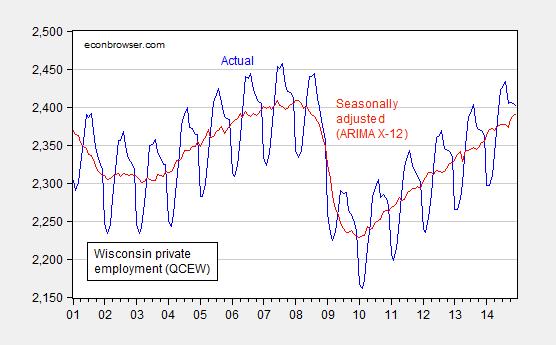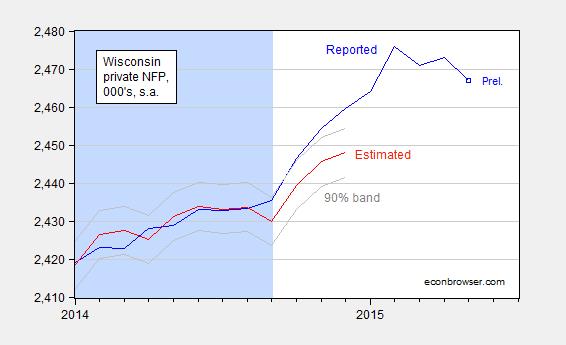Wisconsin released Quarterly Census of Employment and Wages (QCEW) data yesterday (as well as nonfarm payroll employment (NFP)) [1] [2]. We can use these data to update the estimate of nonfarm payroll employment (which is important given concerns about the accuracy of the establishment survey based series). Doing so worsens the employment performance through 2014.
Recall, the reported DWD series incorporate QCEW data only up through 2014M09. We will have to wait until the next benchmark to see subsequent QCEW data incorporated directly into the NFP and private NFP series (which have been falling over the last three months in Wisconsin).
I take QCEW private employment data from 2001M01-2014M12, seasonally adjust using ARIMA X-12 (multiplicative seasonal factors), to obtain the adjusted series. Both are presented below in Figure 1.

Figure 1: Wisconsin Quarterly Census of Employment and Wages private employment seasonally unadjusted (blue), and seasonally adjusted using ARIMA X-12 multiplicative terms (red). Source: DWD, and author’s calculations.
I then run a regression of log WI private nonfarm payroll employment on log seasonally adjusted QCEW private employment, over the 2001M01-2014M09 period (the most recently benchmarked state level NFP numbers are benchmarked through 2014M09). I use this relationship to estimate out-of-sample through 2014M12 (the last observation reported for QCEW yesterday was 2014M12). The fitted values and 90% band are shown in Figure 2.
Figure 2: Wisconsin private nonfarm payroll employment (blue), and predicted (red). Light blue shading denotes data used for regression. Source: DWD and author’s calculations.
This implies that the WI private NFP number for December 2014 will be around 2448, which compares to the currently reported value of 2460.
For discussion of how the Wisconsin employment surge of 2013 was “benchmarked away”, see this post.

Yet, over the past four years, employment growth increased much faster than population growth in Wisconsin than the U.S..
Just a reminder that neither party nor fiscal policy prevents a politician from undue optimism (that’s a euphemism for hyperbole).
http://www.usnews.com/opinion/blogs/nancy-pfotenhauer/2014/05/22/obama-fails-to-deliver-on-jobs-and-fiscal-reform-promises
http://www.utsandiego.com/news/2015/jun/04/the-green-jobs-myth-here-we-go-again/
http://www.politico.com/story/2015/05/class-of-2015-faces-grim-job-hunt-118304.html
One must take what politicians say with a grain of salt: http://www.panorama-photo.net/photo/12427.jpg
Menzie –
Isn’t this data granular enough to determine which sectors are underperforming the US average and which ones are overperforming? When I did this a few months ago I was surprised to see that many sectors were outperforming the US, including government employment, and that, if I recall correctly, it was primarily the service sector that was underperforming the US.